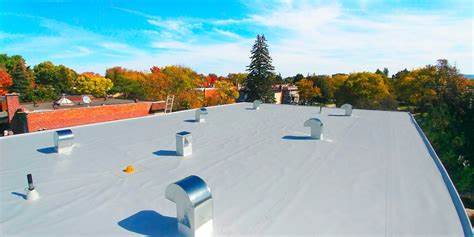Introduction
Protecting roofs from the heat of sunlight and harsh weather is very important. Because from this protection you can achieve a lot of benefits. Many homeowners and industrialists use different kind of roofing for this purpose. TPO roofing membrane is also a roofing type that is used for the protection of the roofs. TPO word is driven from Thermoplastic Polyolefin. The color of TPO roofing is bright white. It is classified as single-ply roofing. TPO-based products are approximately forty years old. However, the first TPO roofing membrane was developed in 1989.
Since then, the use and popularity of TPO membranes have been increasing daily. The growth of TPO roofing is high-speed and rapid. That is why knowing about TPO roofing membrane is very important these days. This article provides an in-depth understanding of TPO membranes.
Benefits that a TPO roofing membrane can give you
TPO roofing membranes can help and benefit you in several ways. Some of the main benefits and their details are described below.
Durability
Most of the TPO roofing membranes are very rigid and durable. These roofing are used to provide excellent resistance to weather harshness. The temperature-bearing capabilities of TPO roofing are also unique. It can stand very high and hot summer temperatures. Whether winters, monsoons, or summers, TPO roofing can easily bear the damages of all seasons. Due to its white color, TPO roofing also provides strong protection against the heat of sunlight and reflects the heat. It also provides resistance against harmful ultraviolet (UV) rays of sunlight.
Great energy efficiency
The energy efficiency provided by the TPO roofing membrane is superb. It saves a lot of energy, especially in the hot summer season. Because the TPO membrane blocks the sun’s heat from penetrating the roof, commercial or residential buildings consume much less energy.
Color of TPO roofing membrane
TPO roofing membrane looks excellent on the roofs of commercial or residential buildings. The most commonly used color of TPO roofing membrane is white; however, this roofing is also coming in the following colors:
- Black
- Gray
- White
On low slope roofs, the color of the TPO roofing membrane matters a lot. So, choose the color of TPO roofing according to the appearance of your building. You can get maximum advantage from white color TPO roofing.
Long-term performance with long life
TPO roofing with a thickness of 80 mils can give you long-lasting protection. Most companies give you a full thirty years guarantee. But the average life of a TPO roofing membrane is about thirty to eighty years. Because this roofing membrane is made of plastic, it can get less wear and tear. And corrosion did not take over this roofing membrane. All these factors contribute to the life-enhancing of roofing membranes.
Waterproof
TPO roofing membrane is made with pure plastic material. Plastic has very tough waterproof properties. If you choose a TPO membrane for your roof, then this is sure that your roof will not damage by water.
Cost-effective
In addition to being very cost-effective, TPO membranes are an appealing option for commercial structures. TPO roofing offers almost the same advantages as PVC roofing but at a much more reasonable price.
Easy installation
TPO membranes are lightweight and come in wide rolls, making them easy to install, and they do not require many seems to be welded. As TPO is so easy to install, labor costs are reduced, resulting in even more significant savings for the customer.
The cost of TPO roofing membrane
The cost of a TPO roofing membrane depends on many factors. The access to the roof, roof area, installation cost, and membrane type are the main factors contributing to calculating the total roofing cost. The typical average cost of TPO roofing stands between 3 US dollars to 9 US dollars per square foot and seven thousand US dollars to eleven thousand dollars per roof.
TPO roofing is very lightweight and easy to carry; the labor cost is less than other types of roofing. Another reason for its lower labor cost is its easy installation process.
The drawback of TPO membrane roofing
When choosing TPO roofing for your buildings, looking at the second side of the coin is essential. Despite the many advantages of TPO roofing, it also has some disadvantages.
The first disadvantage of TPO roofing is the questionable age of this roofing. Although some experiments and experiences prove that the roofing age is between 30 to 80 years, as this is a Modern era roofing system, the age could be less than that.
- Although TPO is a versatile and durable material that resists mold growth, tears, punctures, and dirt accumulation, it does not always stand up well to extreme temperatures. Furthermore, it has been reported to suffer from accelerated weathering when subjected to high thermal or solar loads.
- It is also possible to find TPO roof layers of varying quality among TPO manufacturing companies. Compounds in roofs have changed in recent years, and it is impossible to predict their longevity. Also, flat roofs accumulate water more quickly, so leaks are more likely to occur.
TPO roof membrane: what is it?
Describe the TPO Membrane. TPO is a single-ply roofing membrane made of thermoplastic polyolefin, and it is now one of the commercial/residential roofing systems with the quickest growth rates. TPO roofing systems cover flat roofs and consist of a single layer of synthetic materials and reinforcing scrim.
How long is a TPO roof expected to last?
The expected lifespan of a thermoplastic olefin (TPO) roof is between 22 years and 30 years. They are attached to a polyester scrim to strengthen the two thermoplastic layers and create a single ply that will protect your roof.
Final thoughts
Despite the bad aspects of the TPO roofing membrane, it is still one of the best flat roofing materials. Choices that fit almost any commercial building design and energy-efficiency benefit both; there’s no wonder its popularity is continuously increasing.
FAQs
- Is a TPO roof better than PVC?
PVC and TPO roofing have similar benefits, such as being heat weldable and energy-efficient, but choosing a TPO roof is much more cost-effective.
- EPDM or TPO, which is the better roofing material?
TPO is more stable due to its dimensions. Roofing with EPDM can cause problems because it is prone to shrinkage.
- Which paint could be used to paint TPO?
According to recommendations from a national coating and paint company in Canada, elastomeric paint is the best paint to paint a TPO roof. You do not need a surface primer if you use good-quality elastomeric paint.












